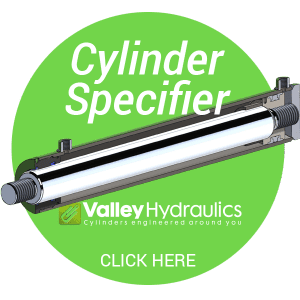Issue
Sign that this is happening
Potential Cause
How to check if this is the issue
External oil leaks near seals
Visibly see external oil leakage around the components fitted with seals
- Seals are damaged
Inspect seals for signs of damage
- Contamination in oil has damaged seals
Inspect seals for signs of damage and inspect fluid for evidence of debris
- Piston rod is damaged and has damaged seals
Fully extend the piston rod and inspect the surface for damage, also inspect seals for signs of damage
- Over pressurisation
Check seal rating, examine seals for deformation & investigate the potential causes for pressure intensification within the cylinder
- Seals not compatible with fluid media
Inspect seals for signs of damage/deformation and check the compatibility of seal material with fluid
- Damage to the surface finish of the seal housing grooves due to corrosion
Inspect seal grooves for signs of corrosion
- Seal housing sizes incorrect
Dimensionally check and compare the seal groove sizes against manufacturers specification
- Incorrect seals fitted
Check seal part codes and ensure they match the manufacturers specification
- Metal to metal clearances around the seals are incorrect
Inspect all metal components for signs of wear then dimensionally check components against manufacturers specification
- Excessive side loading
Visually inspect metal components, bearing rings and seals for signs of excessive wear which will generally appear in one area
External oil leaks near weld
Visibly see external oil leakage around the weld
- Shock loading
Visually check for oil leakage around the weld then check the operating parameters
- Defect in weld
Visually check for oil leakage and signs of cracking around the weld, there may be a slight pinhole causing the leak
Piston rod damaged/bent
Visibly see external oil leakage where the rod enters the cylinder body, the movement during actuation may not be smooth and the pressure may need to be increased to actuate the cylinder
Debris in cylinder
Fully extend the piston rod and inspect the surface for scoring along the length and inspect the oil for signs of debris
- Excessive side loading
Fully extend the piston rod and inspect the surface for signs of excessive wear/damage in one area
- Structure or external part hitting the piston rod during operation
Fully extend the piston rod and inspect the surface for localised damage then observe the cylinder during actuation
- Cylinder loading greater than the piston rod rating
Check piston rod for signs of bending and check manufacturers operating parameters of cylinder against actual loadings
- Not enough overlap in the cylinder
Check piston rod for signs of bending and check for signs of wear on the surface of the rod where it has come into contact with other metallic components.
- Corrosion on the surface of the piston rod
Fully extend the piston rod and inspect the surface for signs of pitting, check the compatibility of rod material with environmental conditions
Main tube bore scored
Cylinder may not hold pressure, the movement during actuation may not be smooth and the pressure may need to be increased to actuate the cylinder
Debris in cylinder
Inspect the tube bore, piston and piston seal for scoring along the length and signs of debris, also inspect the oil within the cylinder for debris
- Excessive side loading
Inspect the tube bore for signs of excessive wear in one area, also inspect the tube and piston for signs of metal to metal contact
- Clearance between metallic components
Inspect the tube bore for signs of excessive wear then dimensionally check components against manufacturers specification



